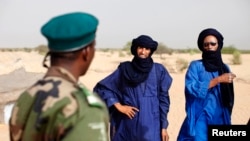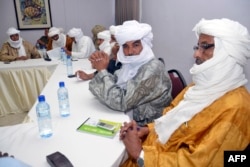When Timbuktu was liberated in 2013, many Arab and Tuareg residents fled out of fear of retribution after being accused of supporting the Islamist occupation. Now many are returning to find they are still under suspicion.
On the northwestern edge of Timbuktu, where the city gives way to the endless Sahara, a young man, a Tuareg, sits in front of a mud house. He’s playing an n’goni, a string-instrument common in West Africa. As the Islamist militias gained ground in 2012, he fled to the desert like many Arabs and Tuaregs.
Later he got a ride to Mauritania’s capital Nouakchott on the Atlantic coast, where he went looking for work. He only returned last year after French troops pushed the Islamists out of major towns in northern Mali in January 2013.
Many have returned to Timbuktu only to find their shops and homes were vandalized and looted. And to find they are not so welcomed.
Traditionally nomadic, Arabs and Tuaregs make up about 13 percent of Mali’s 15.9 million people - the majority of whom are black. Following the liberation, light-skinned Tuaregs and Arabs were viewed as sympathetic to the Islamist occupation.
Some had, in fact, been given senior positions within the armed groups. But many were just traders - who depended on goodwill from the militants in order to transport their goods along roads and sell them at markets controlled by the Islamists.
Some who stayed here paid with their lives. Human rights groups say dozens of people were killed by the military during and after the military intervention in early 2013 in Mali. Others disappeared.
Tragic disappearance
The most well-known case is that of a 70-year-old man known as “Vieux Ali,” or “Old Ali.” He was last seen on the morning of February 14 when several witnesses say he was arrested by soldiers, shoved into the back of a truck and put under a blanket.
When Mohamed Ould Ali learned about the disappearance of his relative through family members he returned immediately to Timbuktu to find out what happened to his “uncle.”
“Every time I asked I was told the investigation was underway. No one could tell me what happened to my uncle or the other people who disappeared,” Mohamed Ould Ali says.
Eventually the old man’s body was found in the desert outside of Timbuktu. Other family members and friends remain missing, says Mohamed Ould Ali.
“There are cases where family members have identified their relatives. In other cases they haven’t even found the body,” Ali says.
Fear of jihadists lingers
Almost two years after the French-led intervention to free the northern two-thirds of Mali, the people of Timbuktu still reel from the violence forced on them by the armed rebels who occupied the city.
There is fear of the jihadists - who may not be in control now, but are here. And the fear of arbitrary arrests by the Malian military remains.
In town, peacekeepers patrol the streets. Arab and Tuareg residents say the presence of international soldiers does make them feel safer than in the desert.
Inside a flat-roofed house made of sun-dried mud, a group of men gathers. They include Oumar Ould Salem, who spent many months in the desert during the occupation and the intervention and is now returning.
“Timbuktu wasn’t safe so I decided to leave, only to find that the desert wasn’t secure either. Bandits profiting from the rebellion hijacked cars and stole cattle. Some of them worked with the rebels,” Ould Salem says.
With the presence of international forces, he hopes the population of Timbuktu can live in peace.
Hoping for peace
“I left Timbuktu and stayed abroad for a long time. It wasn’t until I heard calm had returned that I finally dared to go back. I hope that people of all ethnicities can live together,” Salem says.
Others, however, are less optimistic. In January, the UNHCR estimated 180,000 Malian refugees remained in neighboring countries, mainly Niger, Burkina Faso and Mauritania. More than 100,000 remain internally displaced - many of them Tuaregs and Arabs.
A stone’s throw away from Timbuktu’s famed Sankore Mosque is the recently restored mayor’s office. During the occupation, the rebels, and later the Islamists, looted and destroyed regional government buildings.
Sitting behind his desk, the deputy mayor, Kalifa Ag Imama, says continued insecurity and a slow return to the rule of law prevent many of the refugees and displaced from returning.
“The jihadists have left Timbuktu, however we still have a long way to go before the city will return to normal - the way it was before the rebellion,” Kalifa Ag Imama says.
Sporadic violence continues with armed groups targeting U.N. troops and the general population. The government remains weak and courts and security forces are not yet up and running. Until they are, many residents will not return home.












